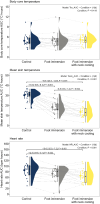Foot immersion with and without neck cooling reduces self-reported environmental symptoms in older adults exposed to simulated indoor overheating
- PMID: 39583896
- PMCID: PMC11583589
- DOI: 10.1080/23328940.2024.2394341
Foot immersion with and without neck cooling reduces self-reported environmental symptoms in older adults exposed to simulated indoor overheating
Abstract
While foot immersion and neck cooling have been recommended for protecting heat-vulnerable groups, recent evidence does not support their efficacy for mitigating increases in physiological heat strain in older adults. However, their influence on self-reported environmental symptoms and mood-state remains unclear. Seventeen older adults (nine females, median [interquartile range] age: 72 [69-74]) completed three randomized heat exposures (6-h; 38°C, 35% relative humidity) with no cooling (control), foot immersion to mid-calf in 20°C water for the final 40-min of each hour (foot immersion), or foot immersion with a wet towel (20°C) around the neck (foot immersion with neck cooling). Core temperature, skin temperature, and heart rate areas under the curve (AUC) were assessed as indicators of cumulative physiological strain. Environmental symptom scores (68-item environmental symptoms questionnaire) and mood disturbance (40-item profile of mood states questionnaire) were evaluated at end-heating (adjusted for pre-exposure). Core temperature AUC was not different between conditions (p = 0.418). However, the skin temperature and heart rate AUCs were 11.8°C · h [95% confidence interval: 8.1, 15.5] and 12.5 bpm · h [0.1, 24.8] lower for foot immersion and 16.6°C · h [12.9, 20.3] and 19.6 bpm · h [7.2, 32.0] lower for foot immersion with neck cooling compared to control (p ≤ 0.032). Environmental symptom scores were 0.8-fold [0.6, 1.0] lower for both foot immersion with and without neck cooling, compared to control (both p = 0.036). Mood disturbance was not different between conditions (both p ≥ 0.275). Foot immersion with and without neck cooling reduces self-reported environmental symptoms in older adults despite having little effect on physiological heat strain.
Keywords: Cooling interventions; heat stress; heat wave; psychometric stress; thermoregulation.
© 2024 The Author(s). Published by Informa UK Limited, trading as Taylor & Francis Group.
Conflict of interest statement
No potential conflict of interest was reported by the author(s).
Figures





References
-
- Henderson SB, McLean KE, Lee MJ, et al. Analysis of community deaths during the catastrophic 2021 heat dome: early evidence to inform the public health response during subsequent events in greater Vancouver, Canada. Environ Epidemiol. 2022;6(1):e189. doi: 10.1097/EE9.0000000000000189 - DOI - PMC - PubMed
LinkOut - more resources
Full Text Sources
Other Literature Sources
